
Pseudotsuga is a genus of evergreen coniferous trees in the family Pinaceae.

The Douglas fir is an evergreen conifer species in the pine family, Pinaceae. It is native to western North America and is also known as Douglas-fir, Douglas spruce, Oregon pine, and Columbian pine. There are three varieties: coast Douglas-fir, Rocky Mountain Douglas-fir and Mexican Douglas fir.

Pseudotsuga menziesii var. glauca, or Rocky Mountain Douglas-fir, is an evergreen conifer native to the interior mountainous regions of western North America, from central British Columbia and southwest Alberta in Canada southward through the United States to the far north of Mexico. The range is continuous in the northern Rocky Mountains south to eastern Washington, eastern Oregon, Idaho, western and south-central Montana and western Wyoming, but becomes discontinuous further south, confined to "sky islands" on the higher mountains in Utah, Colorado, Arizona and New Mexico, with only very isolated small populations in eastern Nevada, westernmost Texas, and northern Mexico. It occurs from 600 m altitude in the north of the range, up to 3,000 m, rarely 3,200 m, in the south. Further west towards the Pacific coast, it is replaced by the related coast Douglas-fir, and to the south, it is replaced by Mexican Douglas-fir in high mountains as far south as Oaxaca. Some botanists have grouped Mexican Douglas-fir with P. menziesii var. glauca, but genetic and morphological evidence suggest that Mexican populations should be considered a different variety.

David Douglas was a Scottish botanist, best known as the namesake of the Douglas fir. He worked as a gardener, and explored the Scottish Highlands, North America, and Hawaii, where he died. The standard author abbreviation Douglas is used to indicate this person as the author when citing a botanical name.

Firs (Abies) are a genus of 48–56 species of evergreen coniferous trees in the family Pinaceae. They are found through much of North and Central America, Europe, Asia, and North Africa, occurring in mountains over most of the range. Firs are most closely related to the genus Cedrus (cedar). Douglas firs are not true firs, being of the genus Pseudotsuga.
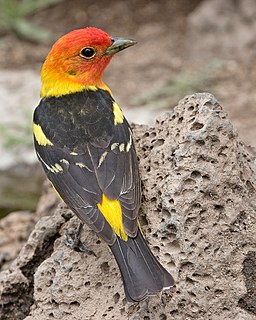
The western tanager, is a medium-sized American songbird. Formerly placed in the tanager family (Thraupidae), other members of its genus and it are classified in the cardinal family (Cardinalidae). The species's plumage and vocalizations are similar to other members of the cardinal family.
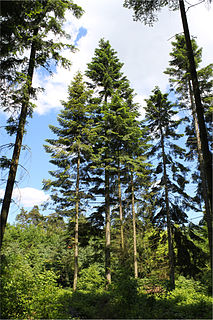
Abies grandis is a fir native to the Pacific Northwest and Northern California of North America, occurring at altitudes of sea level to 1,800 m. It is a major constituent of the Grand Fir/Douglas Fir Ecoregion of the Cascade Range.
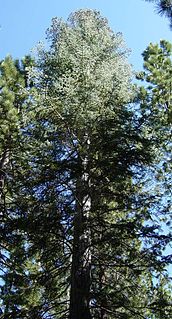
Abies concolor, the white fir, is a coniferous tree in the pine family Pinaceae. This tree is native to the mountains of western North America from the southern Cascade range in Oregon, south throughout California and into the Sierra de San Pedro Mártir in northern Baja California; east through parts of southern Idaho, to Wyoming; and south throughout the Colorado Plateau and southern Rocky Mountains in Utah and Colorado, and into the isolated mountain ranges of southern Arizona, New Mexico and northern Mexico. White fir live over 300 years and naturally occur at an elevation between 900–3,400 m (2,950–11,200 ft).
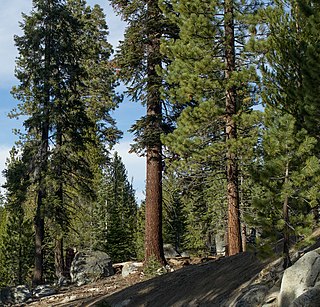
Abies magnifica, the red fir or silvertip fir, is a western North American fir, native to the mountains of southwest Oregon and California in the United States. It is a high elevation tree, typically occurring at 1,400–2,700 metres (4,600–8,900 ft) elevation, though only rarely reaching tree line. The name red fir derives from the bark color of old trees.

Eldorado National Forest is a U.S. National Forest located in the central Sierra Nevada mountain range, in eastern California.

Adams Lake Provincial Park is a provincial park in British Columbia, Canada. It encompasses three distinct parks: Adams Lake Provincial Park, Adams Lake Marine Provincial Park, and Adams Lake Marine Provincial Park.

ȽÁU,WELṈEW̱/John Dean Provincial Park, formerly John Dean Provincial Park, is a small, densely vegetated provincial park on the Saanich Peninsula of southern Vancouver Island, British Columbia, Canada. The park is located on and around ȽÁU,WELṈEW̱, a small mountain in the traditional territory of Wsanec First Nations, itself situated 20 km north of Victoria, the provincial capital city.

Lac La Hache Provincial Park is a provincial park in British Columbia, Canada, located on lake and near community of the same name in the South Cariboo region of that province.

Jackson Demonstration State Forest is a public forest in Mendocino County, California managed by the California Department of Forestry and Fire Protection. It is the largest demonstration forest operated by the State of California. The forest land, located along California State Highway 20 between Willits and the coastal city of Fort Bragg, was formerly owned by Caspar Lumber Company.

The Klamath Mountains ecoregion of Oregon and California lies inland and north of the Coast Range ecoregion, extending from the Umpqua River in the north to the Sacramento Valley in the south. It encompasses the highly dissected ridges, foothills, and valleys of the Klamath and Siskiyou Mountains. It corresponds to the Level III ecoregion designated by the Environmental Protection Agency and to the Klamath-Siskiyou forests ecoregion designated by the World Wide Fund for Nature.
The biogeoclimatic zones of British Columbia are units of a classification system used by the British Columbia Ministry of Forests for the Canadian province's fourteen different broad, climatic ecosystems. The classification system, termed Biogeoclimatic Ecosystem Classification, exists independently of other ecoregion systems, one created by the World Wildlife Fund and the other in use by Environment Canada, which is based on one created by the Commission for Environmental Cooperation (CEC) and also in use by the US Environmental Protection Agency (EPA). The system of biogeoclimatic ecosystem classification was partly created for the purpose of managing forestry resources, but is also in use by the British Columbia Ministry of Environment and Climate Change Strategy and other provincial agencies. A biogeoclimatic zone is defined as "a geographic area having similar patterns of energy flow, vegetation and soils as a result of a broadly homogenous macroclimate."
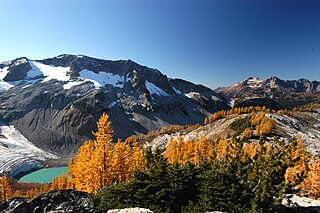
The Ecology of the North Cascades is heavily influenced by the high elevation and rain shadow effects of the mountain range. The North Cascades is a section of the Cascade Range from the South Fork of the Snoqualmie River in Washington, United States, to the confluence of the Thompson and Fraser Rivers in British Columbia, Canada, where the range is officially called the Cascade Mountains but is usually referred to as the Canadian Cascades. The North Cascades Ecoregion is a Level III ecoregion in the Commission for Environmental Cooperation's classification system.

The Ancient Forest Alliance is a grassroots environmental organization in British Columbia, Canada. It was founded in January 2010, and is dedicated to protecting British Columbia's old growth forests in areas where they are scarce, and ensuring sustainable forestry jobs in that province.

Pseudotsuga menziesii var. menziesii, also known as Coast Douglas-fir, Pacific Douglas-fir, Oregon pine, or Douglas spruce, is an evergreen conifer native to western North America from west-central British Columbia, Canada southward to central California, United States. In Oregon and Washington its range is continuous from the Cascades crest west to the Pacific Coast Ranges and Pacific Ocean. In California, it is found in the Klamath and California Coast Ranges as far south as the Santa Lucia Mountains with a small stand as far south as the Purisima Hills, Santa Barbara County. In the Sierra Nevada it ranges as far south as the Yosemite region. It occurs from near sea level along the coast to 1,800 metres (5,900 ft) in the California Mountains. Further inland, coast Douglas-fir is replaced by Rocky Mountain or interior Douglas-fir. Interior Douglas-fir intergrades with coast Douglas-fir in the Cascades of northern Washington and southern British Columbia.
Grandma Tree is a record setting Douglas fir in Oregon. The tree sits near North Fork Coquille River in Coos County. The tree's girth of c. 10 metres (33 ft) is the second greatest of a living Douglas fir in the United States.
















